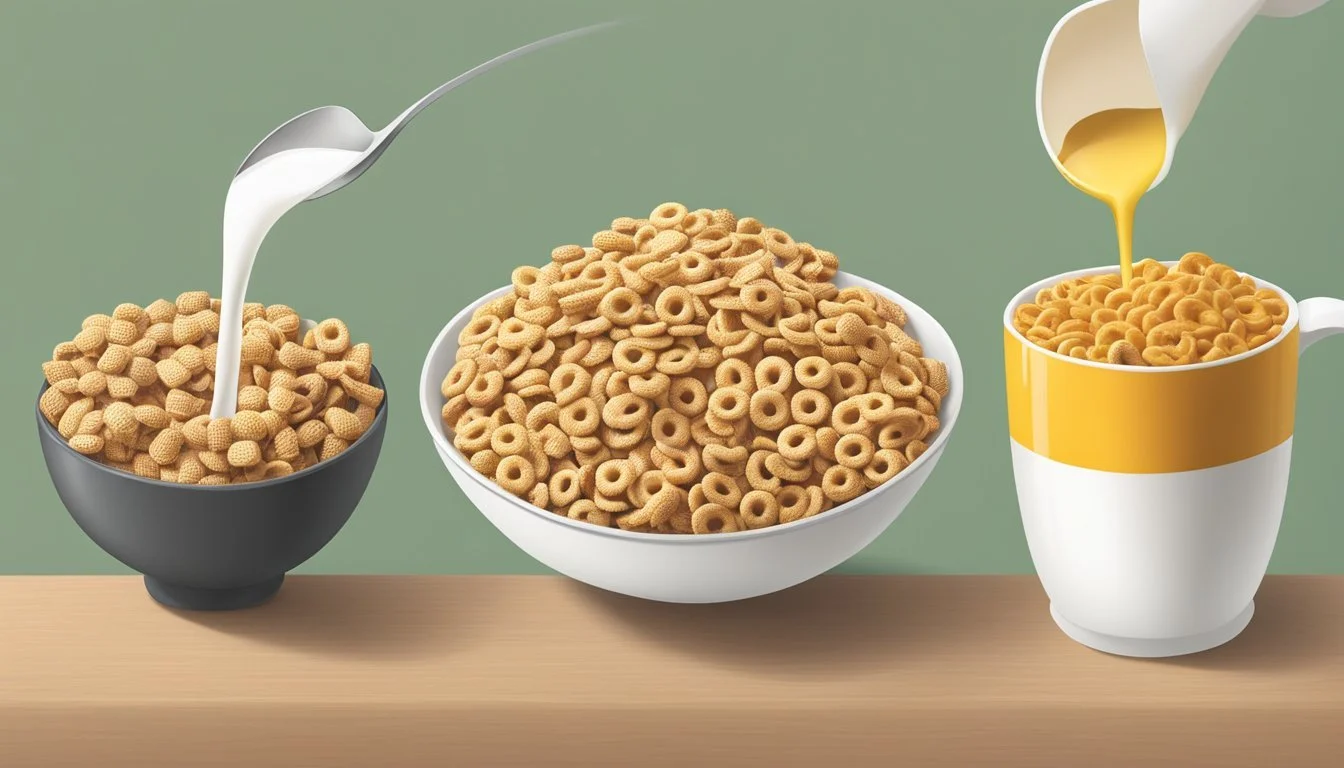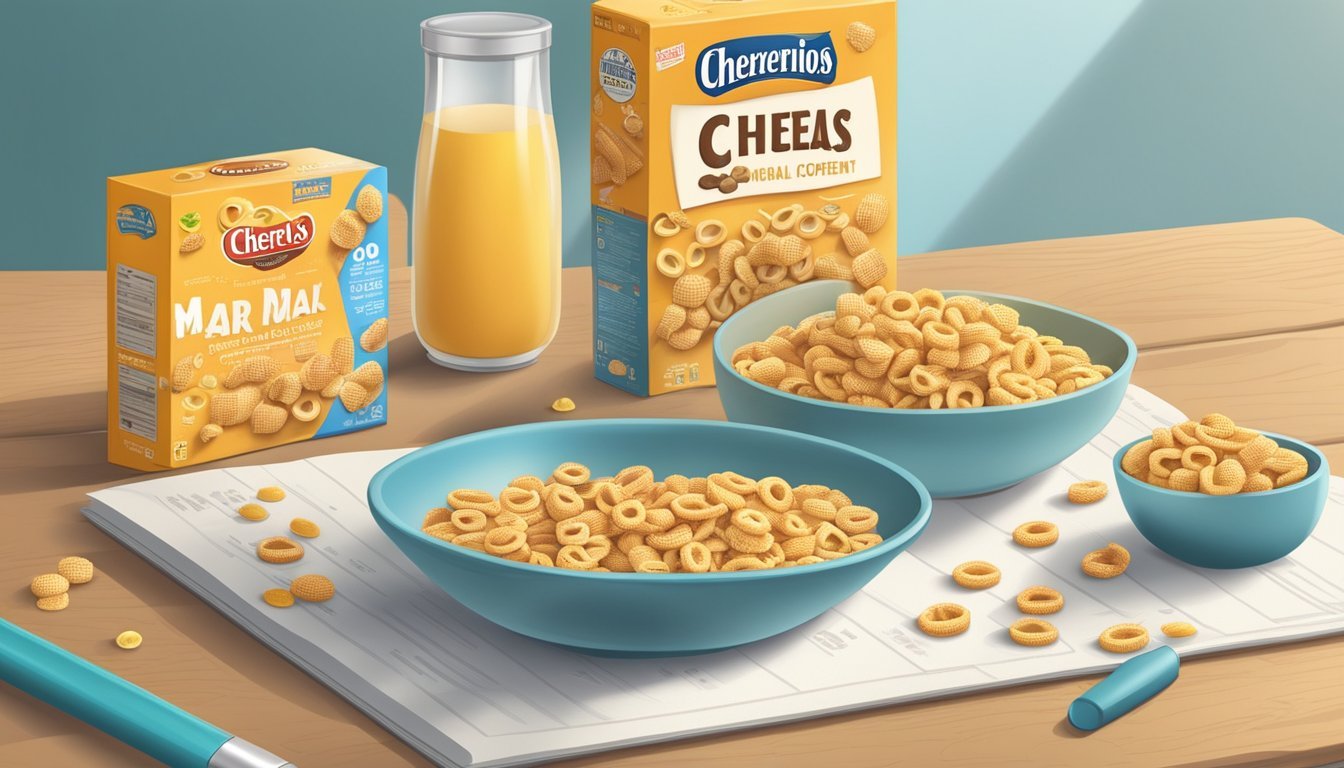Cheerios vs Chex
Comparing Nutritional Benefits
This Article is Part of Our Breakfast Cereal Guide with Details on Cheerios Nutrition and Chex Nutrition
Choosing a breakfast cereal can be a daunting task with numerous options available, but Cheerios and Chex often stand out in the crowded aisle. Both crafted by General Mills, these cereals offer different nutritional profiles that cater to varied dietary needs. Cheerios, known for their simplicity and whole grain oats, provide a balanced option with low calories and a good source of iron, zinc, vitamin B6, and folic acid.
Rice Chex or Corn Chex might appeal to those seeking higher carbohydrate content for more energy in the morning. Rice Chex contains 23 grams of complex carbohydrates per serving, outpacing Cheerios' 17 grams, making it a suitable option for those needing an extra boost. However, the sodium content in Cheerios remains lower, beneficial for those on a low-sodium diet.
For individuals mindful of sugar and fat intake, Cinnamon Chex might be less appealing due to its higher sodium and sugar levels. On the other hand, Cheerios maintain a simple composition with just 100 calories and 3 grams of fiber per serving, making them a nutritious choice across all ages. Understanding these distinctions helps in making a more informed decision about which cereal aligns best with your dietary preferences and needs.
Comparative Overview
Cheerios and Chex, both produced by General Mills, remain popular choices in the breakfast cereal market. Each has its own unique history, evolution in ingredients, and impact on consumer preference.
Manufacturer Profile
General Mills, the manufacturer behind both Cheerios and Chex, has a long-standing history in the cereal industry. Established in 1928, General Mills has consistently been a major player in the breakfast aisle.
Cheerios first hit the shelves in 1941 and quickly became a favorite due to its heart-healthy benefits. Chex, introduced in 1937, came in various grain options like rice, corn, and wheat, catering to different dietary preferences. Both cereals reflect General Mills' commitment to providing nutritious and enjoyable breakfast options.
Cereal Evolution and Trends
Cheerios has evolved significantly since its introduction, initially branded as "CheeriOats." It has expanded its range to include varieties such as Honey Nut Cheerios, Multi-Grain Cheerios, and more. This evolution reflects consumer desire for taste variety and health benefits.
Chex has also diversified, offering options like Rice Chex, Corn Chex, and Wheat Chex. The cereal's trend towards gluten-free offerings has made it a popular choice among those with gluten sensitivities. The shift towards lower sugar and higher fiber variations in both brands shows an ongoing trend towards healthier breakfast choices.
Market Position and Popularity
In terms of market position, Cheerios remains one of the top-selling cereals in the United States. Its reputation for being a healthy breakfast option, particularly for heart health, bolsters its popularity. Continuous advertising and strong branding contribute to its high market visibility.
Chex maintains a strong market presence, partly due to its versatile use in recipes beyond breakfast, such as snack mixes. Its popularity surged with the gluten-free trend, solidifying its position in the market. While both cereals hold significant consumer loyalty, Cheerios tends to lead in overall sales and brand recognition.
Nutritional Content Analysis
Cheerios and Chex cereals are popular breakfast options known for their distinct nutritional profiles. A comprehensive comparison based on macronutrients, vitamins and minerals, added sugars and sodium, and fiber and whole grains reveals the strengths and weaknesses of each cereal.
Macronutrients Comparison
Cheerios and Rice Chex have similar macronutrient distributions, with slight differences in serving sizes. Cheerios contains 17 grams of complex carbohydrates per serving, while Rice Chex offers 23 grams. Both provide a modest amount of protein, with Cheerios offering around 3 grams and Rice Chex approximately 2 grams per serving. Fat content is low in both cereals, with Cheerios containing 2 grams and Rice Chex 0.5 grams per serving. Caloric values are comparable, with Cheerios at 100 calories and Rice Chex at 110 calories per serving. This makes both options relatively low in calories yet energy-efficient.
Vitamins and Minerals Breakdown
Cheerios and Rice Chex are fortified with various vitamins and minerals, enhancing their nutrient density. Cheerios typically contain more iron, providing about 45% of the daily recommended intake per serving, while Rice Chex offers up to 50%. Both cereals are enriched with essential B-vitamins, including B12, contributing to energy metabolism. Cheerios are slightly higher in calcium content, offering around 10% of the Daily Value, whereas Rice Chex contains 2%. Both cereals include vital nutrients such as zinc and vitamin C, though amounts vary slightly.
Added Sugars and Sodium
Cheerios and Rice Chex maintain a relatively low sugar profile compared to other cereals. Cheerios include about 1 gram of sugar per serving, making it an excellent choice for those seeking lower-sugar options. Rice Chex contains more sugar, with up to 8 grams per serving, depending on the flavor. Sodium content is another critical factor; Cheerios have approximately 190 milligrams per serving, while Rice Chex ranges from 250 to 340 milligrams. Those monitoring sodium intake might find Cheerios a more suitable option.
Fiber Content and Whole Grains
Fiber is a key component in maintaining digestive health, and both cereals offer substantial amounts. Cheerios contain about 3 grams of dietary fiber per serving, bolstered by the use of whole grain oats. Rice Chex offers a slightly lower fiber content, around 1 gram per serving. Whole grains are prominent in both cereals; Cheerios are primarily made from whole grain oats, while Rice Chex uses whole grain rice. Whole grains contribute to the nutrient density and provide additional health benefits.
Serving Size and Weight
Cheerios and Chex cereals offer different serving sizes and nutritional profiles. This section breaks down the standard serving sizes and evaluates the nutritional density of each cereal.
Standard Serving Size Comparisons
Cheerios:
Serving size (cups): 1 ½ cups
Serving weight (grams): 39 grams
Serving weight (ounces): 1.37 oz
Rice Chex:
Serving size (cups): 1 ⅓ cups
Serving weight (grams): 40 grams
Serving weight (ounces): 1.41 oz
While Cheerios has a slightly larger serving size by volume, its weight in grams is marginally less compared to Rice Chex. This subtle difference affects how much nutritional content a serving contains. Both cereals have different serving sizes, which may influence portion control and the execution of a balanced diet.
Nutritional Density
Cheerios and Rice Chex vary significantly in their nutritional content per serving:
Grams of fat per serving:
Cheerios: 2 grams
Rice Chex: 0.5 grams
Grams of dietary fiber per serving:
Cheerios: 4 grams
Rice Chex: 1 gram
Grams of complex carbohydrates per serving:
Cheerios: 17 grams
Rice Chex: 23 grams
Grams of sugars per serving:
Cheerios: 1 gram
Rice Chex: 2 grams
Milligrams of sodium per serving:
Cheerios: 190 mg
Rice Chex: 240 mg
Milligrams of potassium per serving:
Cheerios: 220 mg
Rice Chex: Information not provided
Overall, Cheerios contains higher dietary fiber and potassium per serving compared to Rice Chex. Yet, Rice Chex offers more complex carbohydrates. The sodium content is slightly higher in Rice Chex, which is worth noting for those monitoring salt intake. The balance between these nutritional elements can help guide decisions based on dietary needs and preferences.
Dietary Considerations
When choosing between Cheerios and Chex cereals, dietary factors such as allergens, caloric content, and regulatory compliance are important to consider.
Gluten-free and Allergen Information
Many Chex varieties, including Rice Chex and Corn Chex, are labeled as gluten-free, making them suitable for individuals with celiac disease or gluten intolerance.
Cheerios, on the other hand, are made from oats, which are naturally gluten-free but often contaminated with gluten during processing. General Mills has implemented strict protocols to ensure that Cheerios are gluten-free, but consumers with severe gluten sensitivity should exercise caution.
Aside from gluten, both cereals are free from common allergens like nuts and soy, but it’s always best to check the packaging for potential cross-contamination warnings.
Lower Calorie Options
Caloric intake is a key consideration for those monitoring their weight or calorie consumption. Cheerios typically have around 101 calories per one-cup serving (28g).
In comparison, Rice Chex contains similar calorie counts, with a serving size of 1 ⅓ cup (40g) amounting to approximately 160 calories. Wheat Chex and Corn Chex also fall within a comparable calorie range, highlighting the options for those seeking lower-calorie cereals.
For those counting calories, both Cheerios and Chex offer viable low-calorie breakfast choices with slight variations in serving sizes and total caloric intake.
FDA Recommendations Compliance
Cheerios and Chex cereals align with various FDA dietary recommendations, including limits on sodium, sugar, and fat. Cheerios, for instance, contains around 136mg of sodium and 1.7g of fat per serving, which fits well within FDA guidelines for a balanced diet.
Chex cereals vary slightly but also maintain compliance, offering cereals low in fat and sugar.
Both cereals contribute to daily nutritional goals by providing a good source of whole grains. However, consumers should verify specific varieties for exact compliance with FDA recommendations, particularly if they are managing specific dietary restrictions or health conditions.
Brand Variants and Alternatives
Cheerios and Chex offer a wide array of variants catering to different nutritional needs and taste preferences. The following subsections detail these variants and explore comparable alternatives from other brands.
Cheerios Varieties
Cheerios, produced by General Mills, has expanded far beyond the original flavor. Honey Nut Cheerios is one of the most popular varieties due to its sweetness and nutty flavor. There's also Multigrain Cheerios, which combines oats, barley, corn, and rice for a more wholesome breakfast option.
For those watching their sugar intake, Cheerios Protein and Cheerios Oat Crunch provide more substantial, protein-rich choices. Gluten-free Cheerios cater to those with gluten sensitivities, and seasonal editions like Pumpkin Spice Cheerios add variety through the year.
Chex Varieties
Chex, another General Mills brand, offers a robust range of options. Rice Chex and Corn Chex are staples, beloved for their simplicity and versatility. Wheat Chex offers a whole grain alternative packed with fiber.
For those interested in more adventurous flavors, Chocolate Chex and Honey Nut Chex provide sweet options. Chex also appeals to the gluten-free community with Gluten-Free Chex and to those needing a nutrient boost with Vanilla Chex.
Comparative Brands
Several brands offer alternatives to Cheerios and Chex. Post’s Shredded Wheat and Raisin Bran are high-fiber options that compete with Wheat Chex. Kellogg’s Special K and Nutri-Grain bars provide whole grain and low-sugar options.
Cracklin' Oat Bran and Golden Grahams from Kellogg's offer other tasty, nutritious choices. Basic 4 and Fiber One cereals from General Mills might appeal to those seeking variety and higher dietary fiber.
These alternative brands ensure that consumers have multiple options catering to various dietary needs and flavor preferences, making the breakfast cereal market versatile and adaptable.
Consumer Insights
Cheerios maintains a dominant market presence, whereas Chex has a notable but lesser preference. Consumers often have varied opinions on taste and texture between these two cereals. Various ratings and surveys highlight how each brand is viewed.
Taste and Texture Preferences
Taste and texture play crucial roles in consumer choices between Cheerios and Chex. Cheerios are often praised for their mild sweetness and crunchy texture. Many consumers appreciate their ability to stay crunchy in milk without getting soggy quickly.
Chex, on the other hand, is favored for its crispiness and versatility. The unique texture makes it suitable for a variety of uses beyond a breakfast cereal, such as in snack mixes. Consumers often highlight the distinct texture and neutral taste that can blend well with other ingredients.
Cereal Ratings and Popular Opinion
Market data suggests that Cheerios is the leading brand among consumers. It is the most popular cereal in the U.S. with a favorable rating of 62% among adults. This shows a significant increase from 57% in the previous year.
Chex cereals holds a favorable opinion among 49% of U.S. adults, which places it second in line. These ratings reflect consumer preferences and market trends. Both cereals have their loyal consumer bases, with Cheerios taking the lead in overall popularity.






